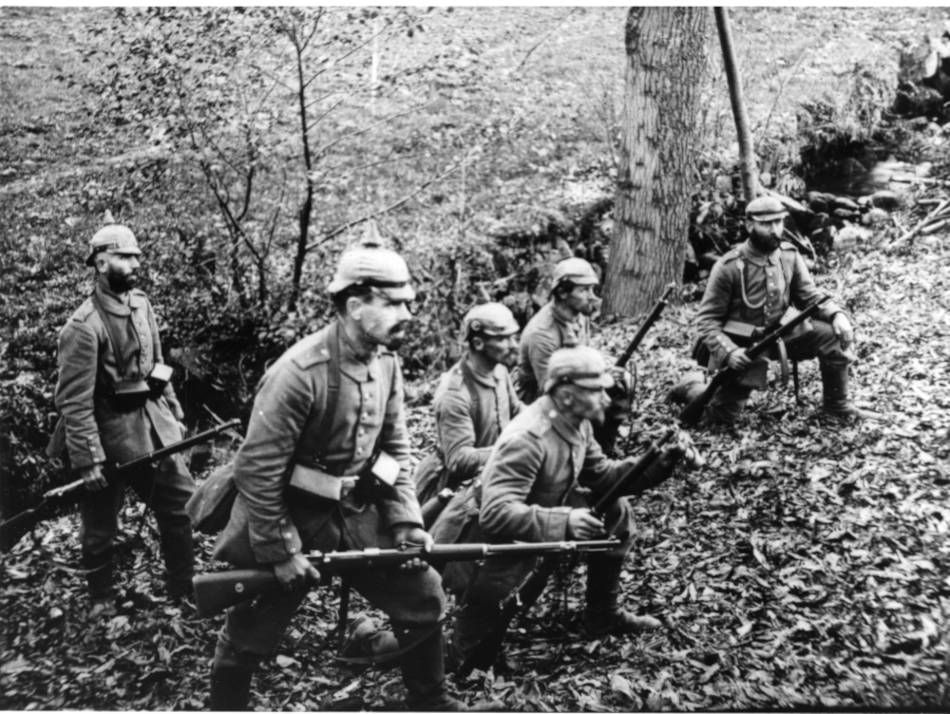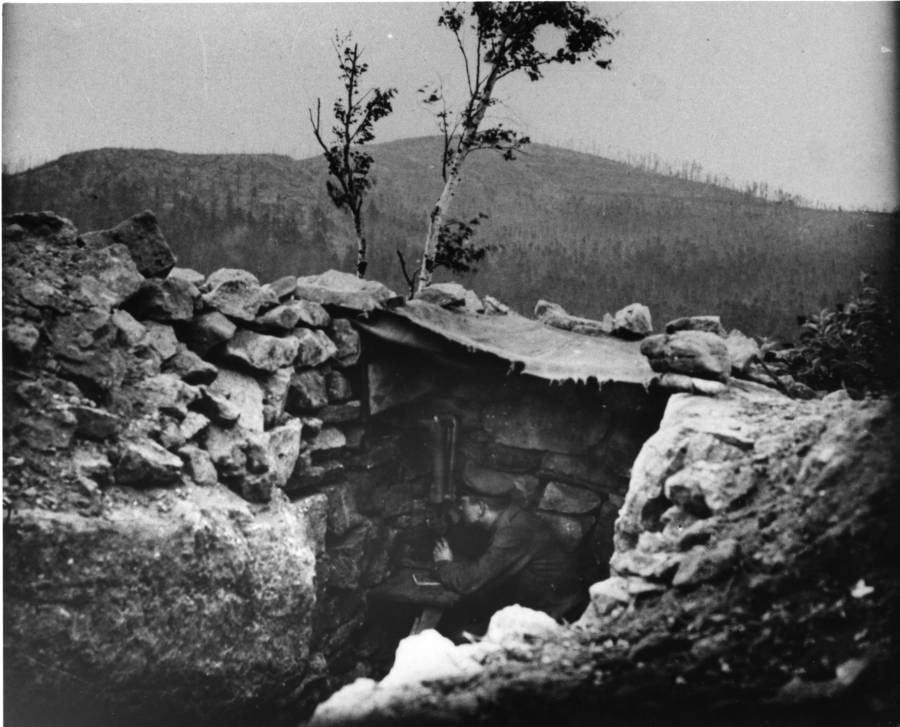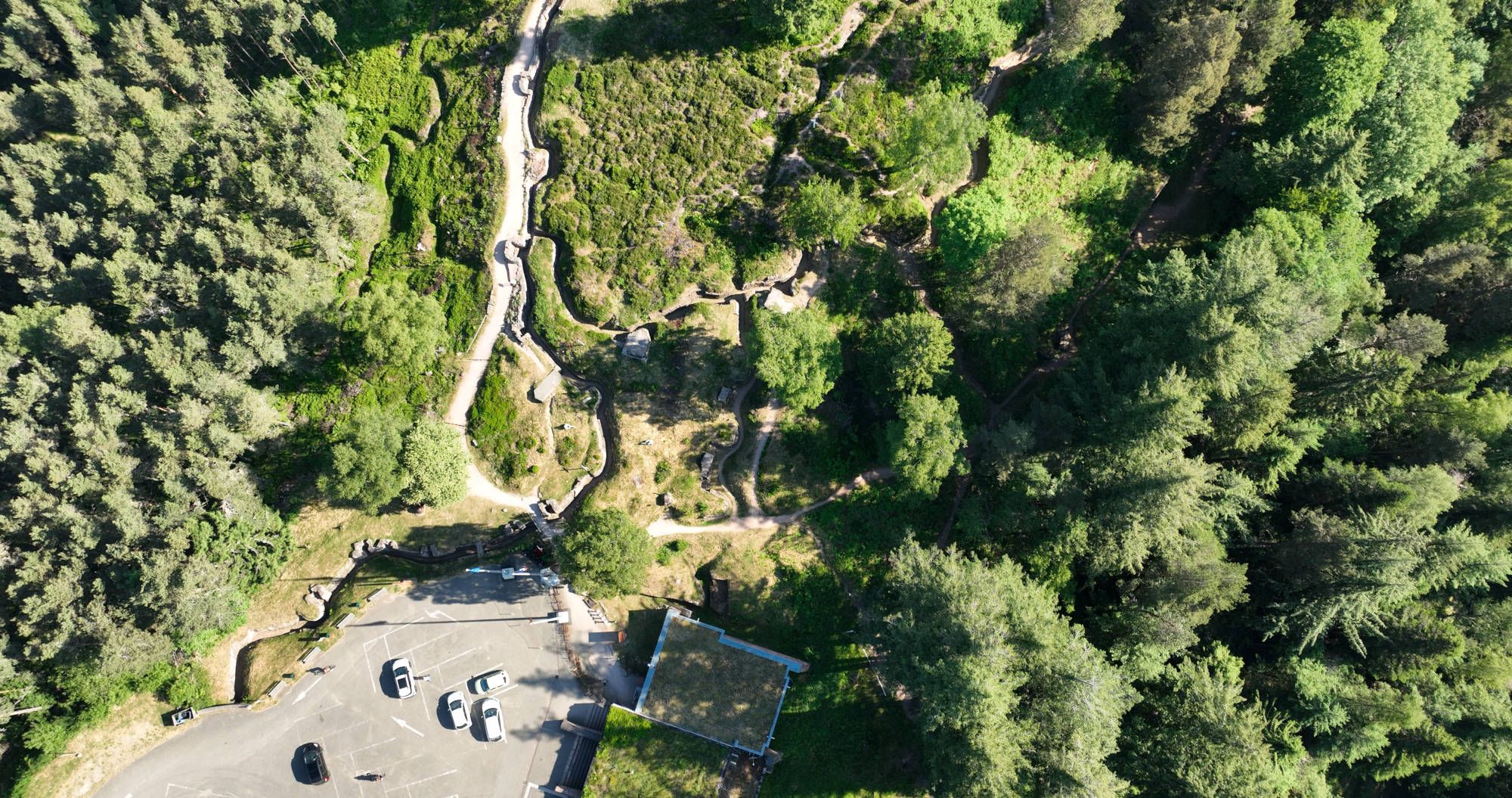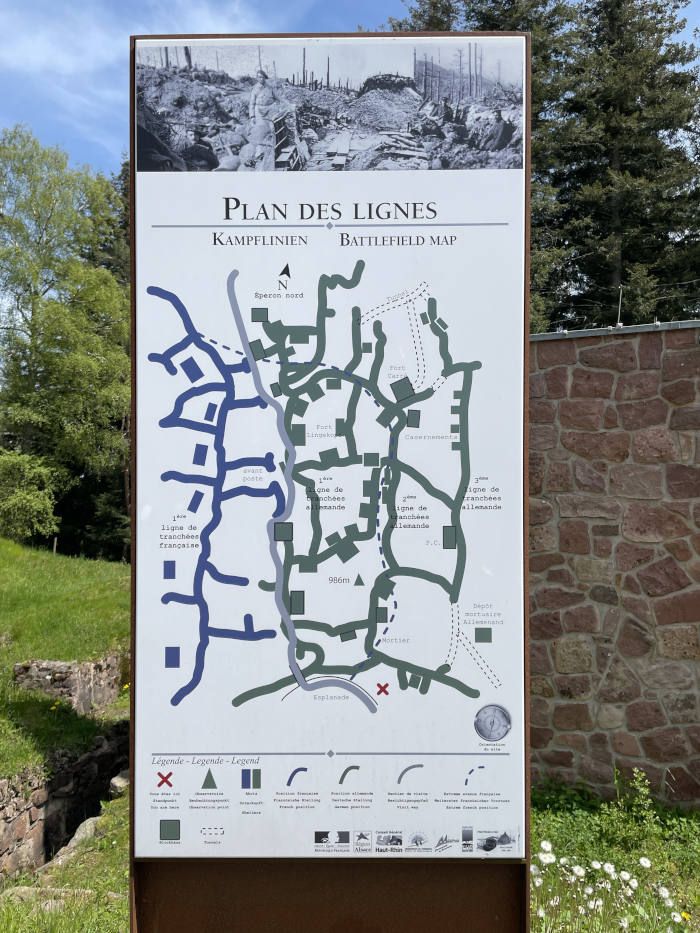The Linge battlefield
The Linge battlefield, land of sacrifice and remembrance
Before 1914, we were in Germany, as Alsace and part of Moselle have been part of Reischland Elsass-Lothringe since 1871. The Linge is a crossing point on an unremarkable secondary ridge, one of many places to go for a walk, with dense forest and paths, and no buildings.
1914-1915
The transformation of the Linge into a Bastion
A major point of German defense
In the summer of 1914, after the declaration of war, no one really paid much attention to this place, which had nothing to do with its immediate future, and which was only temporarily and successively occupied by a few soldiers from each side.
It was in the autumn of 1914, after the French troops had withdrawn, that the German command holding this ridge undertook to develop it into a major defense point. While the battle was already raging in other nearby locations (Tête des Faux, Metzeral, Reischakerkopf, etc.), a particularly long and harsh winter delayed the French plan to attack this position. This allowed German troops and engineers to continue reinforcing the structure, taking care to preserve the natural mask of the forest as much as possible against any attempt at detection.
So, when the assault was finally launched by the French General Staff under the blazing sun of July 1915, the French Chasseurs discovered the full extent of an impregnable position barely scratched by French heavy artillery at the limit of its range.

1916-1918
Le Linge after the assault
Fixed lines and fighting the elements
The summer's terrible fighting ceased with the onset of winter, leaving behind a deeply mutilated battlefield ploughed by artillery fire of all calibres.
They also eliminated a considerable number of soldiers on each side, whether wounded, dead or missing, never to be found, buried or pulverized by machine-gun fire and explosions.
Fearing another large-scale attack, the German General Staff reorganized the battlefield in the light of its proven weaknesses, revising its organization in depth and reinforcing its positions even further. Then, as the battle doctrine changed, positions were adjusted or abandoned.
But while the fighting shifted to other sites without losing intensity, it resumed here only in the form of sporadic hand-to-hand combat and artillery exchanges of varying but regular importance, as the French command considered this area to be of lesser importance.
Despite this, the soldiers in position will be under constant threat from rifles, grenades and artillery from the other side, day and night, as they battle against the elements, the cold, the rain and the heat, in what is certainly less discomfort for the defenders.


From oblivion to light
In November 1918, the Armistice marked the end of this terrible war, in which millions of men lost their lives and countless others lost their minds, limbs or were disfigured (les gueules cassées). The Linge battlefield, witness to fierce fighting, remains devastated and scarred.
Traces erased by oblivion
Wishing to turn this bloody page and consign it to history, France was quick to wipe out most of the traces of this fighting, declaring only the Crête du Linge (1921), the Hartmannswillerkopf and the Tête des Faux historic sites, while many other sites were simply abandoned with their numerous remains (Hilsenfirst, Reischacker, Violu, etc.).
Demining, cleaning, filling in trenches and reforesting were all part of the process of restoring a more natural look to these blood-soaked lands in the post-war years.
Le sommeil du Linge
And so, little by little, from 1919 onwards, the Linge fell asleep and was forgotten. Nature reclaimed its rights and the remains were gradually covered over, almost disappearing completely in the shade of the foliage. However, the memory of the soldiers has never been forgotten, commemorated by the annual August ceremony at the Wettstein national necropolis.

48 years of oblivion
A sad destiny for a land that saw the worst violence unleashed for 3 months, drinking the blood of so many soldiers, only to fall under the leaden blanket of oblivion that even the 2nd World War avoided.
It's a sad fate for this land to be denied the memory of the many French and German soldiers whose remains still lie within its walls, and whose surviving comrades are trying to retrace their steps during a pilgrimage to the site.
It's a sad fate for a piece of land that's just good enough to take in the garbage, illegal dumping and used oil of local residents who are hardly grateful for this sacrifice...
Awakening consciences
48 years old!
48 years will have passed since the end of the conflict, leaving the blood to dry up and the memory to fade into oblivion and total anonymity.
48 years before chance (or fate? ) brought together a French veteran of these battles, shattered by the oblivion into which his comrades had fallen , and a Colmar historian always ready to fight injustice.
The rebirth of remembrance
48 years before awareness finally awakens after this chance encounter, we are in 1967.
1968, a historic springtime is in the offing, one that will bring about profound changes in society. But this spring will also see the almost miraculous rebirth of this historic site, which will take its revenge on oblivion by gradually becoming a major witness to the little-known history of the fighting in the Vosges, as the fiftieth anniversary of the end of this tragic "der des der" approaches.
It will take the courage and pugnacity of a group of friends who will make it their mission to give back to this place and to these valiant fighters all the honour and recognition they deserve, despite the reluctance of the authorities.
Soon joined by the Army and dozens of volunteers, they cleaned up, cleared brush, cut down trees, cleared almost invisible trenches, uncovered impressive quantities of equipment and munitions, and found the remains of soldiers who would finally be honored with solemnity, some in the presence of their families... 50 years later.
Most of these pioneers have now left us, but they have passed on the torch that for over 50 years has kept this site alive, year after year, through the healthy commitment of new members.A memorial museum for eternity

Starting with a few souvenirs in a wooden hut, the association went on to build a small museum-memorial, which it has been able to bring to life and expand as time goes by , developing its mission of passing on the memory to younger generations by explaining in detail why and how these battles took place and their consequences at every level.
An enduring light
More than a hundred years have now passed... the direct witnesses have long since left us, but the site and the museum are now in the spotlight, known and recognized. They will slowly move from the transmission of Memory to the explanation of History through an exhibition constantly renewed and enriched by new means so that this light does not fade away!

The Linge battlefield today
The battlefield you are visiting today is a living witness to the history that unfolded here over a period of almost 4 years. But this witness, while compelling and extremely demonstrative of the extreme difficulty for the attackers to take the place, is only a small remnant of the battlefield that stretched over 2300 meters, between the northern spur of the Linge ridge and the Baerenkopf in the south, passing through the Schratzmaenelle.
In fact, after the Great War, it was decided to return most of the battlefield to civilian use, leaving only the Linge ridge (Lingekopf) to be classified.
On the other hand, the organization and layout of German defenses were radically reworked in the wake of the terrible fighting of summer 1915, to reinforce weak points and then adapt to the new doctrines of site use.
Today, you're walking through this battlefield in its "end-of-war" state, and some places, while no longer reflecting the reality of the fighting of the time, may seem incredibly close, and in any case much closer than they actually were in 1915.

